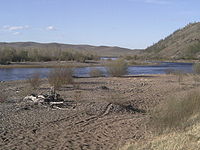- Tomb of Genghis Khan
-
The location of the tomb of Genghis Khan (died 1227) has been the object of much speculation and research. As of 2011, the site remains undiscovered.
Contents
Historical accounts
Genghis Khan asked to be buried without markings. After he died, his body was returned to Mongolia and presumably to his birthplace in the Khentii Aimag, where many assume he is buried somewhere close to the Onon River. According to legend, the funeral escort killed anyone and anything across their path, to conceal where he was finally buried.[citation needed] After the tomb was completed, the slaves who built it were massacred, and then the soldiers who killed them were also killed.[1] The Genghis Khan Mausoleum is his memorial, but not his burial site. Folklore says that a river was diverted over his grave to make it impossible to find (the same manner of burial of Sumerian King Gilgamesh of Uruk).[1] Other tales state that his grave was stampeded over by many horses, that trees were then planted over the site, and the permafrost also did its bit in the hiding of the burial site.[1] The Erdeni Tobchi (1662) claims that Genghis Khan's coffin may have been empty when it arrived in Mongolia. Similarly, the Altan Tobchi (1604) maintains that only his shirt, tent and boots were buried in the Ordos (Ratchnevsky, p. 143f.). Tumbull (2003, p. 24) tells another legend according to which the grave was re-discovered 30 years after Genghis Khan's death. According to this tale, a young camel was buried with the Khan, and the camel's mother was later found weeping at the grave of its young.
Marco Polo wrote that, even by the late 13th century, the Mongols did not know the location of the tomb. The Secret History of the Mongols has the year of Genghis Khan's death but no information concerning his burial. In the "Travels of Marco Polo" he writes that "It has been an invariable custom, that all the grand khans, and chiefs of the race of Chingis-khan, should be carried for interment to a certain lofty mountain named Altaï ,and in whatever place they may happen to die, although it should be at the distance of a hundred days' journey, they are nevertheless conveyed thither." Marco Polo also writes that Chingis-khan died "in the siege of a castle named Thaigin, he was struck by an arrow in the knee, and dying of the wound, was buried in the mountain of Altaï." Other sources name the area of the Burkhan Khaldun mountain as his burial site (roughly 48°30′N 108°42′E / 48.5°N 108.7°E). The area near the Burkhan Khaldun was called the Ikh Khorig, or Great Taboo. This 240 square-kilometer area was sealed off by the Mongols, with trespassing being punishable by death. It is only within the last 20 years that the area has been open to western archeologists.
Search
There were rumours concerning a standard containing clues to the site that had been removed by the Soviets from a Buddhist monastery in 1937, and rumours concerning a curse leading to the death of two French archaeologists (comparable to the curse of the tomb of Tamerlane, Gur-e Amir).
On October 6, 2004, "Genghis Khan's palace" was allegedly discovered, and that may make it possible to find his burial site.[2]
Amateur archaeologist Maury Kravitz has dedicated 40 years to the search of the tomb. In a 15th-century account of a French Jesuit, he found a reference to an early battle where Genghis Khan, at the time still known as Temüjin, won a decisive victory. According to this source, he selected the confluence of the Kherlen and "Bruchi" rivers, with Burkhan Khaldun over his right shoulder, and after his victory, Temüjin said that this place would be forever his favourite. Kravitz, convinced that Temüjin's grave would be near that battlefield attempted to find the "Bruchi" river, which turned out to be unknown to cartographers. He did, however, discover a toponym "Baruun Bruch" ("West Bruch") in the area in question, and as of 2006 is conducting excavations there, roughly 100 km east of the Burkhan Khaldun (48°N 110°E / 48°N 110°E, the wider area of Bayanbulag).
References
Footnotes
- ^ a b c Lost Histories by Joel Levy. Published by Vision Paperbacks, London: 2006. ISBN 978-0-7394-8013-7. pages 172-179.
- ^ "Remains of Genghis Khan palace unearthed". Associated Press. 2004-10-06. http://www.msnbc.msn.com/id/6189531/. Retrieved 2009-07-10.
- Ratchnevsky, Genghis Khan. Blackwell Publishing, 1993. ISBN 0-631-18949-1. Pages 142-143.
- Tumbull, Mongol Warrior 1200-1350 (2003)
External links
Categories:- Genghis Khan
- Asian archaeology
Wikimedia Foundation. 2010.

